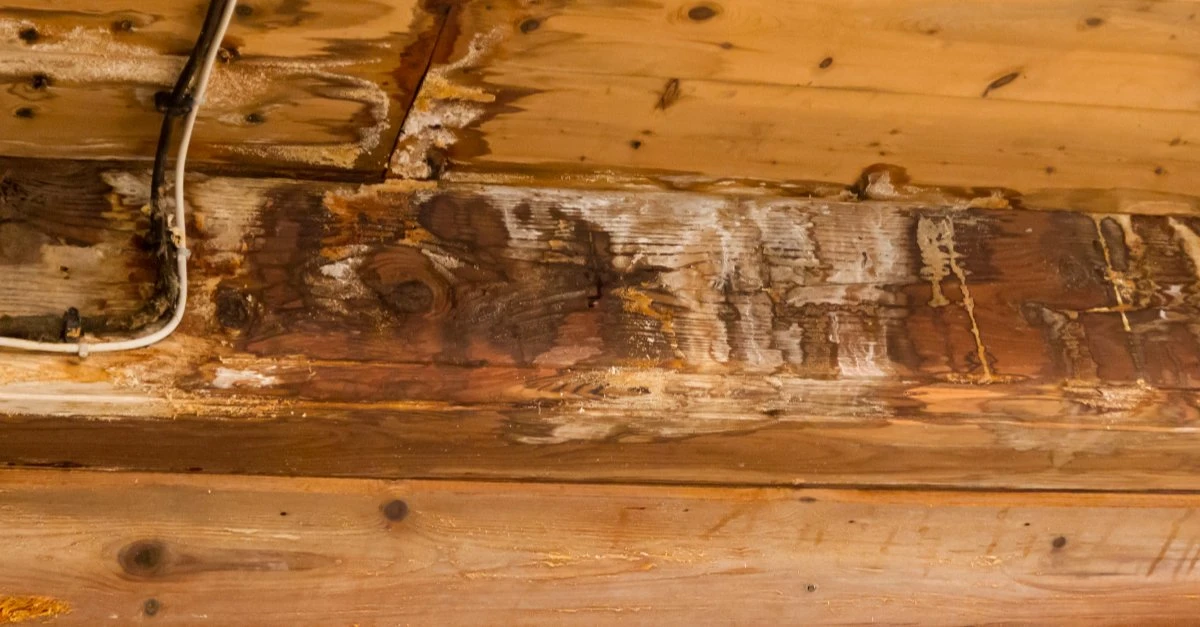Wood Rot Treatment Charleston: Know the Enemy
When you’re ready to jump into the fight against rotted wood, it’s helpful to know about the enemy you’re fighting. Why does wood rot affect outdoor surfaces and items more than indoor ones? What are the types of rot? Here’s what Charleston homeowners should know.
We’ve all seen wood rot before, many times throughout our lives. Whether you jumped on an old log while you were out for a stroll in the forest, and it crumbled apart under your feet, or you’ve had the unpleasant experience of watching parts of your home crumble and deteriorate before your very eyes, it’s an inescapable part of life that everyone encounters at some point—especially in Charleston, SC. So why are local homes and commercial properties so prone to needing Charleston wood rot repair? It all comes down to moisture.
Wood rot is a type of decay that occurs in timber with a high excess moisture content of around 20% or higher. Charleston is blessed with a subtropical climate that keeps temperatures warm and mild throughout the year—but also brings plenty of rain and humidity blowing in from the Atlantic. That means our outdoor surfaces and structures are often soaked with rain, and the humidity gives them no chance of drying out before the next deluge. If any outdoor timber is not adequately protected by water-resistant paint, stain and sealant, all that moisture will seep into the wood, and it’s only a short hop from there to full-blown wood rot.
Because wood rot is caused by exposure to excessive moisture, timber that remains completely dry indoors can stay virtually unchanged for more than 100 years, but exterior wood that is exposed to the elements is highly susceptible to decay. That doesn’t mean wood rot can’t make an appearance inside your house, though. Any structures and places where water frequently comes into contact with timber are likely to need Charleston wood rot repair sooner or later. For example, it’s not uncommon to discover rotting wooden trim under or near a sink, especially one that has sprung a small leak.
Common Varieties of Wood Rot
There are actually quite a few different types of timber decay that you may encounter in or near the Charleston area, but most of them stay in nature where they belong and help to decompose fallen trees. When it comes to the varieties that affect residential or commercial properties that require help with a Charleston wood rot repair project, there are three broad categories that property owners should be aware of. They attack different parts of the timber fibers, but all have similar results in that they cause timber to soften and crumble.
- White Rot: This variant attacks lignin, which is part of the structural fibers of timber. It breaks down lignin and leaves the lighter-colored cellulose intact. The material that’s left behind has a whitish or yellowish look and a stringy, spongy texture. It thrives at room temperature, around 65 to 90 degrees Fahrenheit, so building interiors are an attractive place for it to grow, but the climate in Charleston means it’s absolutely capable of growing outdoors here as well.
- Brown Rot: You’ll often hear this type referred to as dry rot, but that’s something of a misnomer—it still needs high moisture content to get started. It attacks cellulose, leaving the darker-colored lignin behind, which causes the timber to shrink and break apart in cube-shaped chunks in a process called a cubical fracture. This variety thrives in the same temperature range as the white variant. However, it is considered more aggressive because, while it only affects timber, it is capable of crossing non-timber materials such as plaster and masonry to reach new patches of timber. This makes seeking dry rot repair right away incredibly important.
- Soft Rot: This variety secretes an enzyme that breaks down cellulose by creating small cavities, which of course, causes the material to soften and break apart. It looks quite similar to the brown variant, but it’s not as aggressive, and it’s more commonly found on fallen logs and other naturally decaying timber in a forest. However, it does thrive in a wider temperature range, from about zero to 110 degrees Fahrenheit, so it is capable of affecting man-made structures that aren’t protected by paint or stain and sealant.
Locations That Typically Require Charleston Wood Rot Repair
Not sure if your property is due (or possibly long overdue) for Charleston wood rot repair service? As we mentioned above, the most glaring sign that rot damage is on its way is moisture exposure, so it makes sense to check the areas where water incursion is most likely to occur. This could include places with a potential hidden plumbing leak, but sometimes it’s less obvious. For example, wooden trim in a bathroom that doesn’t have adequate ventilation is vulnerable because the steam from showers condenses on surfaces and seeps into the wood, elevating its moisture content. When you’re searching for evidence of wood rot, check this list of the most common locations that need wood rot treatment in Charleston:
- Wooden siding
- Timber soffit and fascia boards
- Window sills and frames
- Exterior doors and jambs
- Entryways (over doors)
- Floors in mud rooms and laundry rooms
- Decks and porches
- Stairs or steps
- Fences
- Gazebos, sheds, playhouses and other outdoor structures
- Poorly ventilated bathrooms
- Water leaks under sinks and other water fixtures
- Near water-related appliances such as a water heater or dishwasher
- Around leaking water supply lines
- Attics and crawl spaces
Remember, wood rot is capable of spreading to other parts of your property and can have a serious effect on structural integrity—it doesn’t take an expert to understand that having the framing of your house or support beams crumble apart could lead to a major disaster. That’s why it’s so important to call an experienced professional to repair damaged wood when you notice a problem.
Mr. Handyman is Your Local Charleston Wood Rot Repair Expert
Charleston wood rot repair may seem fairly simple on the surface, but it does require some training and expertise to make sure it’s all completely removed so it doesn’t resurface in a few weeks or months, and also to conceal the repaired area and make it invisible so it doesn’t hurt the appeal of your residential or commercial property. That’s why this particular task is best left to the licensed handyman team at Mr. Handyman of Charleston and Summerville.
Homeowners and business owners alike can count on our dedicated professionals to arrive promptly for their scheduled appointment, in uniform and driving a company vehicle so you know who you are letting on to your property. We’ll take the time to check the affected area carefully and carry out a wood rot treatment that will stamp out every last trace of timber decay. We’ll also explain our recommendations clearly and answer all your questions before we get started so you have peace of mind knowing you’re making an informed decision about what’s best for your property.
A locally owned and operated company, Mr. Handyman of Charleston and Summerville is spearheaded by an owner with 40 years of experience working in the area. Equipped to build a home from the ground up, our incredibly talented crew is both drug and alcohol screened and has received background checks to give our customers the utmost confidence in what we offer.
We’re also licensed to tackle both electrical and plumbing work. Our team of experienced contractors can help with leak repairs to fix any excess moisture issues that may have caused wood rot in the first place. Need additional home improvement services? You can count on us for siding repair, drywall repair, or attic repair jobs too. Call today to speak with a customer care representative or schedule service.
Frequently Asked Questions About Charleston Wood Rot Repair
Many questions can occur on the topic of Charleston wood rot repair, and we hope to have answered quite a few you’ve had in mind. To learn more, check out our answers to some of the most frequently asked questions by customers below. Of course, if you have a more specific question that relates to your unique property, don’t hesitate to give our friendly customer service team a call.
What Does Wood Rot Decay Look Like?
You know where to look and why it’s a problem—but what exactly are you looking for? If you’re ready to investigate your home, grab a flashlight and a screwdriver and go around your property, inside and out, examining as much timber as possible. Pay particular attention to the common areas for Charleston wood rot repair that are listed above. Here are the major signs of wood rot you’re looking for:
- Discolored wood that appears lighter or darker than the rest of the material or has a yellow, white, or purple hue
- Timber is webbed with cracks or breaking into cube-shaped bits in a process called cubical fracture
- Textural changes that cause lumber or wood fiber to look spongy, stringy, or swollen
- Chunks of material falling away from the main structure
In advanced cases, you may notice strong, musty odors coming from the decayed area or actually see mushrooms sprouting from the timber. When you see a suspicious patch, press the screwdriver against it. If it sinks right in with little or no resistance, you need Charleston wood rot repair. Don’t forget to check hard-to-reach areas such as crawlspaces and the attic. It may not be convenient to get up there and look around, but rotten wood in those parts of the house can cause severe structural stability issues.
Can Charleston Wood Rot Repair Restore Timber to Its Former Condition?
Not exactly. Since timber decay eats away at certain wood fibers and removes them from the equation, there’s really no way to make the damaged wood look and function the way it did before it was affected by decay. That’s why the best solution in many cases is to remove the entire piece of wood that has been damaged and replace it with new, pressure-treated wood. Your professional handyman will then coat it with paint or solid stain and follow that up with a thick layer of sealant to give it the protection it needs against moisture incursion.
But in some cases, removing whole pieces of wood isn’t the right way to go about it. The timber might be prohibitively difficult to remove, or maybe the decay was caught early on, and there are only a few minor spots of damage. In situations like that, your handyman may be able to take care of Charleston wood rot repair by scrubbing away the rotted parts with a wire brush and filling the holes with epoxy consolidant. Once the epoxy has dried, we’ll paint over the area to hide the repair.
How Can I Prevent the Need for Wood Rot Treatment in Charleston?
The best way to avoid needing Charleston wood rot repair service in the future is by preventing moisture incursion inside and outside your house. Here are a few tips to help you accomplish that:
- Get regular gutter cleaning and repair to prevent overflow from rain gutters
- Watch for signs that timber is losing its protection, such as peeling paint or flaking stain
- Ensure your bathroom is adequately ventilated during showers
- Wipe up spills on hardwood floors right away
Scheduling annual maintenance appointments with our team of professionals can help as well. We will be able to identify any areas of concern around your home and make further recommendations. Licensed to handle a variety of plumbing jobs, too, we can help safeguard your home against moisture damage by stopping leaks.
What do Pests Have to Do with Wood Rot?
Wood rot and pest infestation aren’t always related, but sometimes the two do cross over. Insects such as wood soldier flies will make a piece of wood their home, consuming it and causing it to decay. This type of decay is not the same as wood rot itself, as one is a fungus, and the other is caused by insect damage.
On the other hand, certain species of bugs love to inhabit the areas where wood rot is present and often make it their breeding ground. Carpenter ants and termites, on the other hand, love to eat rotting wood. Likely, if you have rotting wood inside or outside of your home, you will also notice a pest infestation. The two do not always go hand in hand, but one can sometimes accompany the other.
Mr. Handyman of Charleston and Summerville is one of the few home repair companies that can clear the CL-100 test for termites. If you suspect you have termites in your home, give us a call. We can determine whether you are dealing with an insect infestation or a case of wood rot.
Trust the Pros at Mr. Handyman for Expert Charleston Wood Rot Repair
Do you live in this part of South Carolina encompassing Charleston and nearby communities like Mount Pleasant, Goose Creek, or Moncks Corner? If so, you can count on the team of licensed contractors at Mr. Handyman of Charleston and Summerville for expert wood rot repair and dozens of other reliable handyman services, such as fence repair, deck repair, and gutter cleaning.No matter what you call us for, you can count on a type of service that just isn’t offered by other repair companies. Not only will we pick up the phone when you call, but we’ll always arrive on time, in uniform, ready to get to work. Are you ready to see the difference choosing Mr. Handyman makes? Pick up the phone and give us a call today to find out more or schedule a convenient appointment.
 Click to call
Click to call




